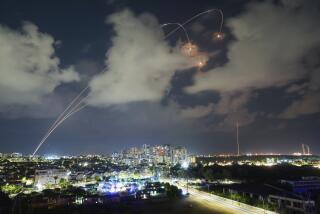They Let Their Feat Do the Talking
- Share via
The Pentagon is being properly cautious about the successful weekend test of its nascent antimissile weapon. Air Force Lt. Gen. Ronald Kadish, head of missile defense programs, was careful to describe it as “just one stop on a journey” that has a long way to go before a credible system to protect against an intercontinental missile attack becomes a reality.
The Bush administration should be no less modest in its assessment and no less prudent in considering the technological obstacles the weapon builders would have to overcome.
Eager to push ahead on a full-scale, multi-tiered missile defense program, the administration has asked Congress for $8.3billion in the 2002 budget to accelerate research and pursue a more aggressive testing program. Its schedule is not dictated by any scientific consensus about what can soon be achieved but instead is based on the dubious concern that in four or five years a rogue state, like North Korea or Iran, might be capable of firing missiles at the United States--and be willing to do so.
In two out of four tests so far, an antimissile “kill vehicle” hit and destroyed a dummy warhead. That is no small achievement. What has yet to be shown is that it’s possible to defend against an attack by multiple warheads accompanied by realistic decoys designed to draw the kill vehicle away from its real targets. It would be folly not to anticipate just such an attack, whether from a rogue state or a major power.
The complex and costly system for an effective defense against this kind of attack is at best a long way off.
Defense Secretary Donald Rumsfeld nonetheless wants to move ahead with a missile defense of limited effectiveness, arguing that even an imperfect system would be a powerful deterrent. But it’s hard to imagine how it would be any greater a deterrent than the virtual certainty that any missile attack on the United States would invite immediate and massive retaliation.
That threat was at the core of the strategy that discouraged direct U.S.-Soviet conflict throughout the Cold War. The Bush administration dismisses it as a relic, along with the 1972 Antiballistic Missile Treaty that was intended to maintain the nuclear balance.
Yet the administration has yet to make a coherent case that the comprehensive missile defense system it favors, involving land, sea and airborne weapons and breakthrough technology, would make the nation any more secure than the threat of nuclear retaliation does today.
The administration, in fact, is having problems explaining where it stands. While Rumsfeld was insisting the other day that the U.S. had no plans to “violate” the ABM treaty, his deputy, Paul Wolfowitz, was suggesting that planned actions--especially starting work on a missile test site in Alaska--could impinge on the treaty within a few months. About all that’s clear at this point is that the administration isn’t sure where it’s going or how it’s going to get there. It just knows it’s in a hurry to be on its way. That is not a sound approach to policymaking.
More to Read
Sign up for Essential California
The most important California stories and recommendations in your inbox every morning.
You may occasionally receive promotional content from the Los Angeles Times.













